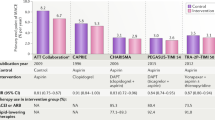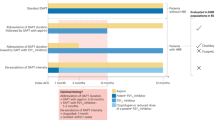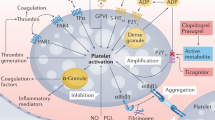Abstract
Aspirin is the foundation antiplatelet therapy for patients at risk of cardiovascular events. The thienopyridine, clopidogrel, is modestly more effective than aspirin and in patients with stroke seems to be as effective as the combination of aspirin and dipyridamole. The addition of clopidogrel to aspirin further reduces the risk of cardiovascular events in patients with acute coronary syndromes and those who undergo percutaneous coronary intervention, but uncertainty remains about whether this combination has incremental efficacy over clopidogrel monotherapy in patients with stroke or peripheral arterial disease. Clopidogrel has pharmacological limitations that have prompted the search for more effective ADP-receptor antagonists. Promising results have been achieved with the thienopyridine, prasugrel, which has been compared with clopidogrel in patients treated with aspirin. The nonthienopyridine P2Y12 inhibitors AZD6140 and cangrelor are presently being evaluated in phase III, randomized, controlled trials.
Key Points
-
Long-term clopidogrel is modestly more effective than aspirin
-
Combined antiplatelet therapy with clopidogrel and aspirin reduces the risk of recurrent cardiovascular events in patients with acute coronary syndromes and those undergoing percutaneous coronary intervention
-
Clopidogrel does have some limitations: slow onset of action; variable inhibition of platelet function; lack of reversibility; and undefined optimum loading dose
-
When administered immediately before percutaneous coronary intervention, prasugrel—a more rapid and more potent P2Y12 receptor inhibitor than clopidogrel—reduces nonfatal myocardial infarction but increases major bleeding events
-
AZD6140 and cangrelor—reversible, nonthienopyridine P2Y12 inhibitors currently being tested—have a more rapid onset and cessation of action than clopidogrel and could reduce acute bleeding risk in patients with acute coronary syndromes requiring early CABG surgery
This is a preview of subscription content, access via your institution
Access options
Subscribe to this journal
Receive 12 print issues and online access
$209.00 per year
only $17.42 per issue
Buy this article
- Purchase on Springer Link
- Instant access to full article PDF
Prices may be subject to local taxes which are calculated during checkout



Similar content being viewed by others
References
Hoffman M et al. (1998) Activated factor VII activates factor IX and factor X on the surface of activated platelets. Blood Coagul Fibrinolyis 9 (Suppl 1): S61–S65
Savage B et al. (1998) Specific synergy of multiple substrate-receptor interactions in platelet thrombus formation under flow. Cell 94: 657–666
Heemskerk JW et al. (1999) Function of glycoprotein VI and integrin α2β1 in the procoagulant response of single, collagen-adherent platelets. Thromb Hemost 81: 782–792
Hechler B et al. (1998) The P2Y1 receptor is necessary for adenosine 5′-diphosphate-induced platelet aggregation. Blood 92: 152–159
Communi D et al. (2000) Advances in signaling by extracellular nucleotides: the role and transduction mechanisms of P2Y receptors. Cell Signal 12: 351–360
Jin J and Kunapuli SP (1998) Coactivation of two different G protein-coupled receptors is essential for ADP-induced platelet aggregation. Proc Natl Acad Sci USA 95: 8070–8074
Kahn ML et al. (1998) A dual thrombin receptor system for platelet activation. Nature 394: 690–694
Vu TK et al. (1991) Domains specifying thrombin-receptor interaction. Nature 353: 674–677
Hirano K (2007) The roles of proteinase-activated receptors in the vascular physiology and pathophysiology. Arterioscler Thromb Vasc Biol 27: 27–36
Antithrombotic triallist's collaboration (2002) Collaborative meta-analysis of randomized trials of antiplatelet therapy for prevention of death, myocardial infarction, and stroke in high risk patients. BMJ 324: 71–86
Van de Werf F (2007) Dual antiplatelet therapy in high-risk patients. Euro Heart J 9 (Suppl): D3–D9
Hass WK et al. (1989) A randomized trial comparing ticlopidine hydrochloride with aspirin for the prevention of stroke in high-risk patients. N Engl J Med 321: 501–507
Caplain H et al. (1999) Pharmacokinetics of clopidogrel. Semin Thromb Hemost 25 (Supp 2): 25–28
Lau WC et al. (2004) Contribution of hepatic cytochrome P4503A4 metabolic activity to the phenomenon of clopidogrel resistance. Circulation 109: 166–171
Savi P et al. (2000) Identification and biological activity of the active metabolite of clopidogrel. Thromb Hemost 84: 891–896
Pereillo JM et al. (2002) Structure and stereochemistry of the active metabolite of clopidogrel. Drug Metab Dispos 30: 1288–1295
Ding Z et al. (2003) Interaction of the human P2Y12 receptor by thiol reagents requires interaction with both extracellular cysteine residues Cys17 and Cys270. Blood 101: 3908–3914
Lau WC et al. (2003) Atorvastatin reduces the ability of clopidogrel to inhibit platelet aggregation: a new drug–drug interaction. Circulation 107: 32–37
Saw J et al. (2003) Lack of adverse clopidogrel–atorvastatin clinical interaction from secondary analysis of a randomized placebo-controlled clopidogrel trial. Circulation 109: 921–924
Saw J et al. (2007) Lack of evidence of a clopidogrel–statin interaction in the CHARISMA trial. J Am Coll Cardiol 50: 291–295
CAPRIE Steering Committee (1996) A randomized blinded trial of clopidogrel versus aspirin in patients at risk of ischaemic events (CAPRIE). Lancet 348: 1329–1339
CURE Trial Investigators (2001) Effects of clopidogrel in addition to aspirin in patients with acute coronary syndromes without ST-segment elevation. N Engl J Med 345: 494–502
Budaj A et al. (2002) Benefit of clopidogrel in patients with acute coronary syndromes without ST-segment elevation in various risk groups. Circulation 106: 1622–1626
COMMIT collaborative group (2005) Addition of clopidogrel to aspirin in 45,852 patients with acute myocardial infarction: randomised placebo-controlled trial. Lancet 366: 1607–1621
Sabatine MS et al. (2005) Addition of clopidogrel to aspirin and fibrinolytic therapy for myocardial infarction with ST segment elevation. N Engl J Med 352: 1179–1189
Steinhubl SR et al. (2002) Early and sustained dual oral antiplatelet therapy following percutaneous coronary intervention. JAMA 288: 2411–2420
Mehta S et al. (2001) Effects of pretreatment with clopidogrel and aspirin followed by long-term therapy in patients undergoing percutaneous coronary intervention: the PCI-CURE study. Lancet 358: 527–533
Sabatine MS et al. (2005) Effect of clopidogrel pretreatment before percutaneous coronary intervention in patients with ST-elevation myocardial infarction treated with fibrinolytics, the PCI CLARITY study. JAMA 294: 1224–1232
Smith SC Jr et al. (2006) ACC/AHA/SCAI 2005 guideline update for percutaneous coronary intervention. Circulation 113: 156–175
2007 Writing Group (2007) 2007 Focused update of the ACC/AHA/SCAI 2005 guideline update for percutaneous coronary intervention. Cath Cardiovasc Interv 71: E1–E40
Bhatt DL et al. (2006) Clopidogrel and aspirin versus aspirin alone for the prevention of atherothrombotic events. N Engl J Med 354: 1706–1717
Bhatt DL et al. (2007) Patients with prior myocardial infarction, stroke, or symptomatic peripheral arterial disease in the CHARISMA trial. J Am Coll Cardiol 49: 1982–1988
Diener HC et al. (2004) Aspirin and clopidogrel compared with clopidogrel alone after recent ischaemic stroke or transient ischaemic attack in high-risk patients (MATCH): randomised, double-blind, placebo-controlled trial. Lancet 364: 331–337
Sacco RL et al.; for the PRoFESS Study Group (2008) Aspirin and Extended-Release Dipyridamole versus Clopidogrel for Recurrent Stroke. N Engl J Med 359: 1238–1251
Diener HC et al. (1996) European Stroke Prevention Study 2. Dipyridamole and acetylsalicylic acid in the secondary prevention of stroke. J Neurol Sci 143: 1–13
The ESPRIT Study Group (2006) Aspirin plus dipyridamole versus aspirin alone after cerebral ischaemia of arterial origin (ESPRIT): randomised controlled trial. Lancet 367: 1665–1673
Eikelboom JW and Hirsh J (2006) Bleeding and management of bleeding. Euro Heart J 8 (Suppl): G38–G45
Fourth Joint Task Force of the European Society of Cardiology (2007) European guidelines on cardiovascular disease prevention in clinical practice: executive summary. Euro Heart J 28: 2375–2414
Coons JC and Battistone S (2008) 2007 Guideline update for unstable angina/non-ST-segment elevation myocardial infarction: focus on antiplatelet and anticoagulant therapies. Ann Pharmacother 42: 989–1001
2007 Writing Group (2008) 2007 Focused update of the ACC/AHA 2004 guidelines for the management of patients with ST-elevation myocardial infarction. Circulation 117: 296–329
Balaguer-Malfagon JR et al. (2006) Stent thrombosis in the modern era: incidence, outcomes and predictive factors. Rev Esp Cardiol 59: 842–845
Iakovou I et al. (2005) Incidence, predictors and outcome of thrombosis after successful implantation of drug-eluting stents. JAMA 293: 2126–2130
Ho PM et al. (2007) Clopidogrel and long-term outcomes after stent implantation for acute coronary syndrome. Am Heart J 154: 846–851
Bernardi V et al (2007) Long-term versus short-term clopidogrel therapy in patients undergoing coronary stenting (from the Randomized Argentine Clopidogrel Stent (RACS) trial. Am J Cardiol 99: 349–352
Snoep JD et al. (2007) Clopidogrel nonresponsiveness in patients undergoing percutaneous coronary intervention with stenting: a systematic review and meta-analysis. Am Heart J 154: 221–231
Montalescot G et al. (2006) A randomized comparison of high clopidogrel loading doses in patients with non-ST-segment elevation acute coronary syndromes. J Am Coll Cardiol 48: 931–938
Hochholzer W et al. (2005) Time dependence of platelet inhibition after a 600 mg loading dose of clopidogrel in a large unselected cohort of candidates for percutaneous coronary intervention. Circulation 111: 2560–2564
Price MJ et al. (2006) Onset and offset of platelet inhibition after high dose clopidogrel loading and standard daily therapy measure by a point of care assay in healthy volunteers. Am J Cardiol 98: 681–684
von Beckerath N et al. (2005) Absorption, metabolization, and antiplatelet effects of 300, 600, and 900 mg loading doses of clopidogrel. Circulation 112: 2946–2950
Cuisset T et al. (2006) Benefit of a 600 mg loading dose of clopidogrel on platelet reactivity and clinical outcomes in patients with non ST-segment elevation acute coronary syndrome undergoing coronary stenting. J Am Coll Cardiol 48: 1339–1345
L'Allier PL et al. (2008) Clopidogrel 600 mg double loading dose achieves stronger platelet inhibtion than conventional regimens. J Am Coll Cardiol 51: 1066–1072
Kastrati A et al. (2004) Loading with 600 mg clopidogrel in patients with coronary artery disease with and without chronic clopidogrel therapy. Circulation 110: 1916–1919
Patti G et al. (2005) Randomized trial of high loading dose of clopidogrel for reduction of periprocedural myocardial infarction in patients undergoing coronary intervention (ARMYDA-2). Circulation 111: 2099–2106
Lotrionte M et al. (2007) Meta-analysis appraising high clopidogrel loading in patients undergoing percutaneous coronary intervention. Am J Cardiol 100: 1199–1206
Gurbel PA et al. (2003) Clopidogel for coronary stenting: response variability, drug resistance and the effect of pretreatment platelet reactivity. Circulation 107: 2908–2913
Taubert D et al. (2004) Pharmacokinetics of clopidogrel after administration of a high loading dose. Thromb Hemost 92: 311–316
Giusti B et al. (2007) Cytochrome P4502C19 loss-of-function polymorphism, but not CYP3A4 IVS10+12G/A and P2Y12 T744C polymorphisms, is associated with response variability to dual antiplatelet treatment in high-risk vascular patients. Pharmacogenet Genomics 17: 1057–1064
Staritz P et al. (2008) Platelet reactivity and clopidogel resistance are associated with the H2 haplotype of the P2Y12-ADP receptor gene. Int J Cardiol [doi:10.1016/j.ijcard.2007.12.118]
Gurbel PA et al. (2005) The relation of dosing to clopidogrel responsiveness and the incidence of high post-treatment platelet aggregation in patients undergoing coronary stenting. J Am Coll Cardiol 45: 1392–1396
Angiolillo DJ et al. (2004) High clopidogrel loading dose during coronary stenting: effects on drug response and interindividual variability. Euro Heart J 25: 1903–1910
Angiolillo DJ et al. (2007) Randomized comparison of a high clopidogrel maintenance dose in patients with diabetes mellitus and coronary artery disease: results of the Optimizing Antiplatelet Therapy in Diabetes Mellitus (OPTIMUS) study. Circulation 115: 708–716
von Beckerath N et al. (2007) A double-blind randomized study on platelet aggregation in patients treated with a daily dose of 150 or 75 mg of clopidogrel for 30 days. Euro Heart J 28: 1814–1819
Bonello L and Paganelli F (2008) Two strategies of clopidogrel loading dose to decrease the frequency of clopidogrel resistance in patients undergoing percutaneous coronary intervention. Thromb Res 122: 285–288
Bonello L et al. (2008) Adjusted clopidogrel loading doses according to vasodilator-stimulated phosphoprotein phosphorylation index decrease rate of major adverse cardiovascular events in patients with clopidogrel resistance. J Am Coll Cardiol 51: 1404–1411
Farid NA et al. (2007) The disposition of prasugrel, a novel thienopyridine, in humans. Drug Metab Dispos 35: 1096–1104
Niitsu Y et al. (2005) Pharmacology of CS-747 (prasugrel, LY640315), a novel, potent antiplatelet agent with in vivo P2Y12 receptor antagonist activity. Semin Thromb Hemost 31: 184–194
Brandt JT et al. (2007) A comparison of prasugrel and clopidogrel loading doses on platelet function: magnitude of platelet inhibition is related to active metabolite formation. Am Heart J 153: 66.e9–66.e16
Payne CD et al. (2007) Increased active metabolite formation explains the greater platelet inhibition with prasugrel compared to high-dose clopidogrel. J Cardiovasc Pharmacol 50: 555–562
Jakubowski J et al. (2006) A multiple dose study of prasugrel (CS-747), a novel thienopyridine P2Y12 inhibitor, compared with clopidogrel in healthy humans. Br J Clin Pharm 63: 421–430
Jernberg T et al. (2006) Prasugrel achieves greater inhibition of platelet aggregation and a lower rate of non-responders compared with clopidogrel in aspirin-treated patients with stable coronary artery disease. Euro Heart J 27: 1166–1173
Wiviott S et al. (2007) Prasugrel versus clopidogrel in patients with acute coronary syndromes. N Engl J Med 357: 2001–2015
Serebruany V et al. (2006) Platelet inhibition with prasugrel (CS-747) compared with clopidogrel in patients undergoing coronary stenting: the subset from the JUMBO study. Postgrad Med J 82: 404–410
Wiviott SD et al. (2007) Prasugrel compared with high loading- and maintenance-dose clopidogrel in patients with planned percutaneous coronary intervention: the prasugrel in comparison to clopidogrel for inhibition of platelet activation and aggregation thrombolysis in myocardial infarction 44 trial. Circulation 116: 2923–2932
Husted S et al. (2006) Pharmacodynamic, pharmacokinetics, and safety of the oral reversible P2Y12 antagonist AZD 6140 with aspirin in patients with atherosclerosis: a double-blind comparison to clopidogrel with aspirin. Eur Heart J 27: 1038–1047
Cannon CP et al. (2007) Safety, tolerability, and initial efficacy of AZD6140, the first reversible oral adenosine diphosphate receptor antagonist, compared with clopidogrel, in patients with non-ST-segment elevation acute coronary syndrome: primary results of the DISPERSE-2 trial. J Am Coll Cardiol 50: 1844–1857
Storey RF et al. (2001) Open multicenter study of the P2T receptor antagonist AR-C69931MX assessing safety, tolerability and activity in patients with acute coronary syndromes. Thromb Hemost 85: 401–407
Greenbaum AB et al. (2006) Initial experience with an intravenous P2Y12 platelet receptor antagonist in patients undergoing percutaneous coronary intervention: results from a 2-part, phase II, multicenter, randomized, placebo- and active-controlled trial. Am Heart J 151: 689.e1–689e10
Jacobsson F et al. (2002) Safety profile and tolerability of intravenous AR-C69931MX, a new antiplatelet drug, in unstable angina pectoris and non-Q-wave myocardial infarction. Clin Ther 24:752–765
Greenbaum AB et al. (2007) Preliminary experience with intravenous P2Y12 platelet receptor inhibition as an adjunct to reduced-dose alteplase during acute myocardial infarction; results of the safety, tolerability and effect on patency in acute myocardial infarction (STEP-AMI) angiographic trial. Am Heart J 154: 702–709
Steinhubl SR et al. (2008) Transitioning patients from cangrelor to clopidogrel: pharmacodynamic evidence of a competitive effect. Thromb Res 121: 527–534
Dovlatova NL et al. (2008) The reversible P2Y12 antagonist cangrelor influences the ability of the active metabolites of clopidogrel and prasugrel to produce irreversible inhibition of platelet function. J Thromb Haemost 6: 1153–1159
Bertrand ME et al. (2000) Double-blind study of the safety of clopidogrel with and without a loading dose in combination with aspirin compared with ticloidine in combination with aspirin after coronary stenting. Circulation 102: 624–629
Muller C et al. (2000) A randomized comparison of clopidogrel and aspirin after the placement of coronary-artery stents. Circulation 101: 590–593
Taniuchi M et al. (2001) Randomized comparison of ticlopidine and clopidogrel after intracoronary stent implantation in a broad patient population. Circulation 104: 539–543
Acknowledgements
Charles P Vega, University of California, Irvine, CA, is the author of and is solely responsible for the content of the learning objectives, questions and answers of the Medscape-accredited continuing medical education activity associated with this article.
Author information
Authors and Affiliations
Corresponding author
Ethics declarations
Competing interests
JW Eikelboom has received speakers honoraria and grant/research support from Bayer, Bristol-Myers Squibb and sanofi-aventis.
The other authors declared no competing interests.
Supplementary information
Supplementary Figure 1
Reference list for clinical trials that evaluated ticlopidine, featured in Table 2. Supplementary figure provided as an eps file. (JPG 56 kb)
Rights and permissions
About this article
Cite this article
Raju, N., Eikelboom, J. & Hirsh, J. Platelet ADP-receptor antagonists for cardiovascular disease: past, present and future. Nat Rev Cardiol 5, 766–780 (2008). https://doi.org/10.1038/ncpcardio1372
Received:
Accepted:
Published:
Issue Date:
DOI: https://doi.org/10.1038/ncpcardio1372
This article is cited by
-
Prehospital Adenosine Diphosphate Receptor Blocker Use, Culprit Artery Flow, and Mortality in STEMI: The MADDEC Study
Clinical Drug Investigation (2021)
-
Novel Anti-platelet Agents in Acute Coronary Syndrome: Mechanisms of Action and Opportunities to Tailor Therapy
Current Atherosclerosis Reports (2015)
-
Antiplatelet and Anticoagulant Therapy for Atherothrombotic Disease: The Role of Current and Emerging Agents
American Journal of Cardiovascular Drugs (2013)
-
Targeting von Willebrand factor as a novel anti-platelet therapy; Application of ARC1779, an Anti-vWF aptamer, against thrombotic risk
Archives of Pharmacal Research (2012)
-
New antithrombotic agents—insights from clinical trials
Nature Reviews Cardiology (2010)



